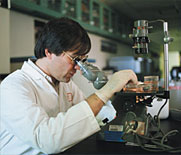 Since 1993, congress has included language in its annual appropriations bill to fund three Contraceptive Research Centers that focus their efforts on research that may lead to new contraceptive products. Recognizing that the complexity of contraceptive research and development can severely limit progress achieved by individual investigators working alone, the NICHD funds these Centers through a specialized cooperative research center award mechanism (U54), in which there is substantial NIH scientific and programmatic involvement with the awardees during performance of the activity. Through its Contraception and Reproductive Health Branch, the NICHD supports three centers, composed of researchers and technical service core facilities that are interactively organized to conduct research for discovering and/or developing promising new leads in regulating fertility, as well as additional relevant projects. The focus of individual projects includes basic, preclinical, or clinical research, or a combination of these areas. The centers also serve as a national resource for career development of young scientists who elect to pursue research in fertility regulation. Funding for each of the centers and related projects runs to 2007.
Since 1993, congress has included language in its annual appropriations bill to fund three Contraceptive Research Centers that focus their efforts on research that may lead to new contraceptive products. Recognizing that the complexity of contraceptive research and development can severely limit progress achieved by individual investigators working alone, the NICHD funds these Centers through a specialized cooperative research center award mechanism (U54), in which there is substantial NIH scientific and programmatic involvement with the awardees during performance of the activity. Through its Contraception and Reproductive Health Branch, the NICHD supports three centers, composed of researchers and technical service core facilities that are interactively organized to conduct research for discovering and/or developing promising new leads in regulating fertility, as well as additional relevant projects. The focus of individual projects includes basic, preclinical, or clinical research, or a combination of these areas. The centers also serve as a national resource for career development of young scientists who elect to pursue research in fertility regulation. Funding for each of the centers and related projects runs to 2007.
Each center consists of three or more projects that are devoted to basic or clinical research on new contraceptives using a variety of approaches: inhibition of spermatogenesis via a number of possible mechanisms, including phosphodiesterase inhibitors, calcium-channel blockers, adherence junctions, and adhesion molecules; hormonal suppression of the hypothalamic-pituitary-gonadal axis in men or women; development of novel vaginal delivery systems for drugs that inhibit ovulation; and analysis of paracrine regulation of oocyte development by cumulus cells. The three centers share common resources and research information throughout their five-year funding period. Emphasis on training opportunities within the centers is also a priority.
Centers are located at:
- University of Washington
- University of California, Davis
- The Population Council
- Jackson Laboratories
- University of Virginia